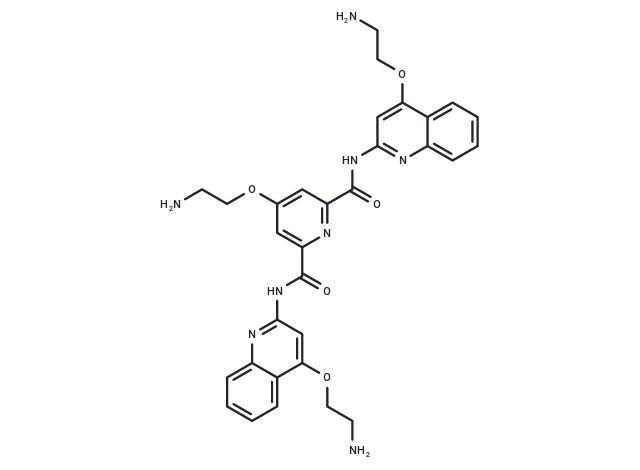Shopping Cart
- Remove All
 Your shopping cart is currently empty
Your shopping cart is currently empty

Pyridostatin (RR82) is a synthetic small-molecule stabilizer of G-quadruplexes, a secondary structure of DNA that usually exists in the end of the chromosome or the telomeres.

| Pack Size | Price | Availability | Quantity |
|---|---|---|---|
| 1 mg | $35 | In Stock | |
| 5 mg | $74 | In Stock | |
| 10 mg | $113 | In Stock | |
| 25 mg | $201 | In Stock | |
| 50 mg | $313 | 1-2 weeks | |
| 1 mL x 10 mM (in DMSO) | $117 | In Stock |
| Description | Pyridostatin (RR82) is a synthetic small-molecule stabilizer of G-quadruplexes, a secondary structure of DNA that usually exists in the end of the chromosome or the telomeres. |
| Targets&IC50 | G-quadruplexe:490 nM(Kd) |
| In vitro | Pyridostatin decreases the proliferation of MRC-5–SV40 cells and various cancer cell lines, and induces cell-cycle arrest by DNA-damage checkpoint activation. Pyridostatin also reduces SRC-dependent cell motility in MDA-MB-231 cells by interacting with G-quadruplex motifs in SRC. [2] Pyridostatin decreases EBNA1 synthesis via inhibition of G-quadruplexes. [3] |
| Kinase Assay | Z-Lyte FRET kinase assay: Kinase inhibition is measured using the Invitrogen Z-Lyte? FRET kinase assay with Ser/Thr 13 peptide substrate based on the myosin light chain sequence KKRPQRRYSNVF. Compounds are tested on three separate days with 8 point dilutions performed in duplicate to determine average IC50 values. The assay conditions are optimized to 15 μL of kinase reaction volume with 5 ng of enzyme in 50 mM HEPES (pH 7.5), 10 mM MgCl2, 1 mM EGTA, and 0.01% Brij-35. The reaction is incubated for 1 h at room temperature in the presence of 1.5 μM of peptide substrate with 12.5 μM of ATP (for ROCK1) or 2 μM of substrate with 50 μM of ATP (for ROCK2). The reaction is then stopped and the ratio of phosphorylated to unphosphorylated peptides is determined by selective cleavage of only the unphosphorylated peptide as described by the manufacturer. This is followed by excitation of coumarin at 400 nm resulting in emission at 445 nm and energy transfer to fluorescein and final emission at 520 nm. The substrate contains both coumarin and fluorescein and only uncleaved phosphorylated substrate will undergo FRET. The ratio of the signals at 445 nm and 520 nm is measured using a Wallac EnVision Plate Reader, model 2102 plate-reader. |
| Cell Research | Cells are plated at equal confluence and are left either untreated or were treated with 2 μM pyridostatin continually during the indicated time before harvesting the cells. Cells from individual plates are trypsinized and counted in a Coulter counter. Graphs represent the total cell numbers at each time interval, and the error bars represent the s.e.m. Data represent three independent experiments.(Only for Reference) |
| Alias | RR82, Pyridostatin Trifluoroacetate Salt |
| Molecular Weight | 596.64 |
| Formula | C31H32N8O5 |
| Cas No. | 1085412-37-8 |
| Smiles | NCCOc1cc(nc(c1)C(=O)Nc1cc(OCCN)c2ccccc2n1)C(=O)Nc1cc(OCCN)c2ccccc2n1 |
| Relative Density. | no data available |
| Storage | Powder: -20°C for 3 years | In solvent: -80°C for 1 year | Shipping with blue ice. | ||||||||||||||||||||||||||||||||||||||||
| Solubility Information | DMSO: 20.85 mg/mL (34.95 mM), Sonication is recommended. Ethanol: 30.87 mg/mL (51.74 mM), Heating is recommended. H2O: 9.66 mg/mL (16.19 mM), Sonication and heating are recommended. | ||||||||||||||||||||||||||||||||||||||||
Solution Preparation Table | |||||||||||||||||||||||||||||||||||||||||
H2O/DMSO/Ethanol
DMSO/Ethanol
Ethanol
| |||||||||||||||||||||||||||||||||||||||||

Copyright © 2015-2025 TargetMol Chemicals Inc. All Rights Reserved.